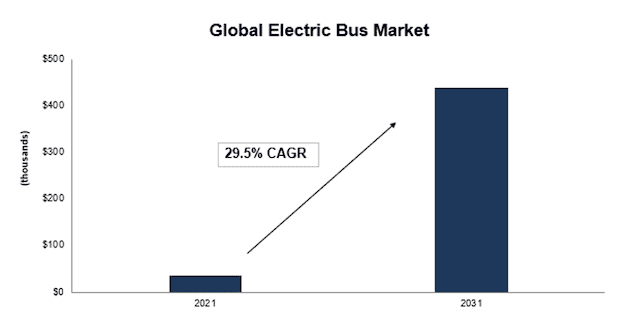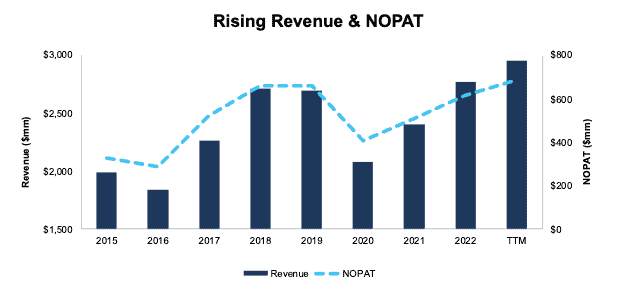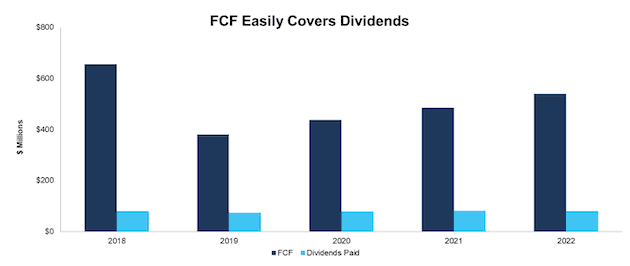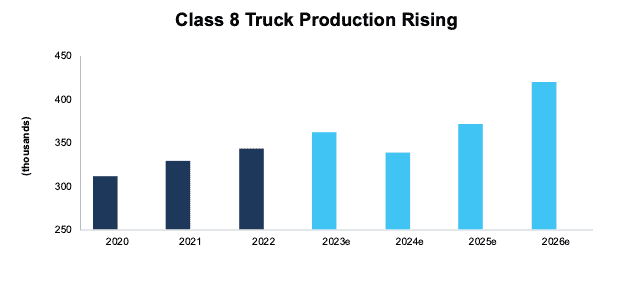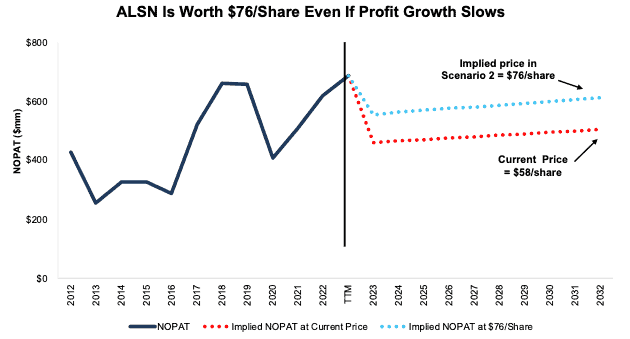We published an update on this Long Idea on August 7, 2024. A copy of the associated report is here.
As a rebuilding of America’s core infrastructure and energy transition is underway, we continue to favor overlooked ‘picks and shovels’ companies with solid fundamentals trading at attractive valuations. Allison Transmission Holdings Inc (ALSN: $58/share), the world’s leading manufacturer of automatic transmissions and commercial propulsion systems, is this week’s Long Idea.
Allison Transmission presents quality risk/reward given the company’s:
- position to benefit from higher fiscal and infrastructure spending,
- strong cash flow generation,
- adaptability to the electric vehicle (EV) market, and
- attractive valuation.
Electric Before It Was Cool
Allison Transmission has been active in the electrified propulsion systems sector for decades. In 2003, the company introduced its H 40/50 EP™ hybrid system for transit buses. Since then, over 9,500 Allison electric propulsion systems have been delivered globally. The systems have been adopted in over 230 cities worldwide and have operated for 3.5 billion miles. Several transportation authorities have chosen to adopt Allison’s systems. The Santa Clara Valley Transportation Authority and the Indianapolis Public Transportation Corporation have incorporated buses equipped with the Allison eGen Flex system into their fleets. Similarly, the Metropolitan Evansville (Indiana) Transit System and Oshkosh’s (Wisconsin) GO Transit have also opted for Allison’s offerings.
To support its electric vehicle initiatives, Allison has established dedicated infrastructure for the development, testing, and manufacturing of electric vehicle technologies. This includes an electric axle manufacturing facility in Auburn Hills, Michigan and a Vehicle Electrification + Environmental Test Center in its Innovation Center, a 96,000-square-foot facility in Indianapolis. This state-of-the-art center focuses on advancing commercial vehicle technology and consolidating engineering teams to promote faster and more efficient product development.
Leading with Hybrid Technologies
More recently, the eGen Flex propulsion system has seen increased adoption by municipalities. The system has achieved over $1.5 billion in sales and has enabled hybrid buses to run in engine-off mode for more than 50% of operating times.
One key feature of this system is its geofencing technology, which allows buses to switch between conventional and electric-only operation in pedestrian and zero-emission zones.
The eGen Flex system is built on an existing hybrid platform, and as a result, it retains 85% of the drive parts, which simplifies the transition for fleet operators.
With a projected compound annual growth rate (CAGR) of 29.5% from 2021 to 2031, the electric bus market stands to drive significant growth for Allison. See Figure 1.
Figure 1: Global Electric Bus Market Forecast: 2021 – 2031
Sources: Allied Market Research
Continuing to Lean Into Electric Technologies
Allison has acquired companies like Vantage Power and AxleTech’s electric vehicle systems division. These acquisitions have expanded Allison’s product range and integrated more advanced capabilities.
Given the current emphasis on infrastructure, climate awareness and increased municipal spending, we expect Allison Transmission to continue to benefit from these tailwinds. With municipal spending driving 30-40% of Allison’s North America On-Highway (the company’s largest segment) market volume, the company has a predictable revenue stream in this sector.
Solid Fundamentals
Allison Transmission has grown both revenue and net operating profit after tax (NOPAT) by 5% compounded annually since 2017. See Figure 2. The company’s NOPAT margin remained unchanged from at 23% from 2017 the trailing twelve months (TTM), while invested capital turns increased from 0.6 to 0.7 over the same time. Improved invested capital turns drive the company’s return on invested capital (ROIC) from 14% in 2017 to 17% in the TTM.
Figure 2: Allison Transmission’s Revenue and NOPAT: 2015 – TTM
Sources: New Constructs, LLC and company filings
Reliable Cash Flows Support Dividends
Allison Transmission has generated positive free cash flow (FCF) every year since 2012 (the first year that we have data for). More recently, the company has leveraged such cash flow and paid $524 million (10% of current market cap) in cumulative dividends since 2017. Shares currently offer a 1.6% annualized yield.
Since 2017, Allison Transmission generated $3.5 billion (44% of enterprise value) in free cash flow (FCF). See Figure 3.
Figure 3: Allison Transmission’s Free Cash Flow and Dividends Paid Since 2017
Sources: New Constructs, LLC and company filings
Not only has Allison Transmission returned capital to shareholders through dividends, but the company has also been repurchasing shares as well. Allison spent $137 million in 1H23 on share buybacks, and over $3 billion since 2017. The company has repurchased 61% of shares outstanding since its IPO. At the 2022 share repurchase rate, the total yield to shareholders rises to 3.4%.
Growth In The Pipeline
Though Allison has been reliable in generating free cash flow and returning capital to shareholders, revenue growth has not been inspiring. However, a confluence of macro tailwinds and new initiatives are driving an encouraging pipeline of growth in Allison’s future.
One such opportunity is the penetration of the Wide Body Mining Dump market with Allison’s 4000 Series™ On-Highway transmission. Already released in all 10 OEMs operating in this space, Allison has experienced a swift rise in market share, especially in the Chinese domestic and global export markets. From 0% market share in 2022, Allison has climbed to approximately 10% in just 18 months, with projections pointing to 25% market share within 3-5 years. This growth translates to a potential $100M annual revenue boost.
In the oil sector, Allison’s Frac Tran, specifically tailored for hydraulic fracturing applications, presents another growth avenue. Launched in 2021, it is undergoing tests across various oilfield fleets in the US. The full growth potential is expected to be realized in 4-5 years, which would create another $100M in annual revenue.
Furthermore, the Class 8 Day Cab and Regional Haul Tractor Market is set to benefit from Allison’s 4000 Series™ and 3414 Regional Haul Series™ transmissions. These systems, which outperform competitors by offering 25% faster acceleration and up to 8% fuel economy improvement, have garnered partnerships with top OEMs, including Daimler and Volvo. The burgeoning infrastructure and construction sectors further amplify this $100M annual revenue prospect, with production expected to increase in the coming years. See Figure 4.
Figure 4: Annual Production of Class 8 Trucks: 2016 – 2026e
Sources: New Constructs, LLC and company filings
Lastly, the defense sector offers vast potential. Allison is primed to benefit from escalating global defense spending driven by unsteady geopolitical dynamics, the conflict in Ukraine, and U.S. Department of Defense (DoD) modernization agendas. Building on its enduring relationship with the U.S. DoD, Allison envisions growth through the sale of existing products to international allies, strengthening bonds with global defense OEMs, and the global interest in their new products. This segment also presents a $100M annual revenue opportunity.
Leading Profits
Allison Transmission’s geographic and product diversification translates into competitive advantages that we can quantify. Over the TTM, the company’s ROIC and NOPAT margin are the highest amongst its peers, which include Cummins Inc. (CMI) and Johnson Controls (JCI). See Figure 5.
Figure 5: Allison Transmission’s Profitability Vs. Peers: TTM
Sources: New Constructs, LLC and company filings
What’s Not Working
Higher Labor Costs Loom
Though NOPAT margins have been rising, from 19.6% in 2020 to 23.3% in the trailing twelve months, Allison’s CFO Fred Bohley signaled that the company is concerned with rising costs, specifically labor. Not only that, the company’s collective bargaining agreement with the United Automobile, Aerospace, and Agricultural Workers of America (UAW) is set to expire in November 2023. Though no information about a renewed agreement is known to us at this time, given the UAW’s ongoing strike within the automotive industry, as well as the CFO’s comments, it is safe to expect that labor costs will represent a bigger piece of the pie in the coming future.
However, with an 18% year-over-year increase in revenue in 2Q23, the company has been efficient at both raising prices and taking market share. From the earnings call: “as costs continue to go up, we definitely have to manage them from a price cost standpoint but it positions us […] (to) deliver a greater value proposition to both further increase market share as well as get price”. In other words, labor costs will rise and pressure margins, but we think this well-run company will continue to find a way to grow profits.
Valuation Provides Upside
Shares Have 31% Upside at Current Price
At its current price of $58/share, Allison Transmission has a PEBV ratio of 0.6, which means the market expects profits to permanently fall 40% from current levels. Below, we use our reverse discounted cash flow (DCF) model to further quantify how low the expectations baked into Allison Transmission’s stock price are. We also present the upside potential in the stock if the company grows NOPAT below historical growth rates.
DCF Scenario 1: to Justify the Current Stock Price
We assume Allison Transmission’s:
- NOPAT margin falls to 16.5% (well below the five-year average NOPAT margin of 22%) from 2023 to 2032 and
- revenue grows just 1% compounded annually (vs. 15% in the TTM) through 2032
In this scenario, Allison Transmission’s NOPAT would fall 2% compounded annually through 2032 and the stock would be worth $58/share today – equal to the current price. For reference, Allison Transmission has grown NOPAT by 5% compounded annually since 2012.
DCF Scenario 2: Shares Have 31%+ Upside Even if Growth Slows
If we instead assume Allison Transmission’s:
- NOPAT margin falls to 18% (lowest since 2016) from 2023 to 2032,
- revenue grows at consensus estimates in 2023 (11%) and 2024 (2%), and
- revenue grows 1% compounded annually from 2025 to 2032 (versus 5% compounded annually since 2017), then
Allison Transmission would be worth at least $76/share today – a 31% upside to the current price. In this scenario, Allison Transmission’s NOPAT in 2032 is about the same as its 2022 NOPAT.
Should Allison Transmission grow profits more in line with historical levels, the stock has even more upside. Figure 6 compares Allison Transmission’s historical NOPAT to the NOPAT implied in each of the above DCF scenarios.
Figure 6: Allison Transmission’s Historical and Implied NOPAT: DCF Valuation Scenarios
Sources: New Constructs, LLC and company filings.
This article was originally published on October 4, 2023.
Disclosure: David Trainer, Kyle Guske II, Italo Mendonca, and Hakan Salt receive no compensation to write about any specific stock, style, or theme.
Questions on this report or others? Join our Society of Intelligent Investors and connect with us directly.

